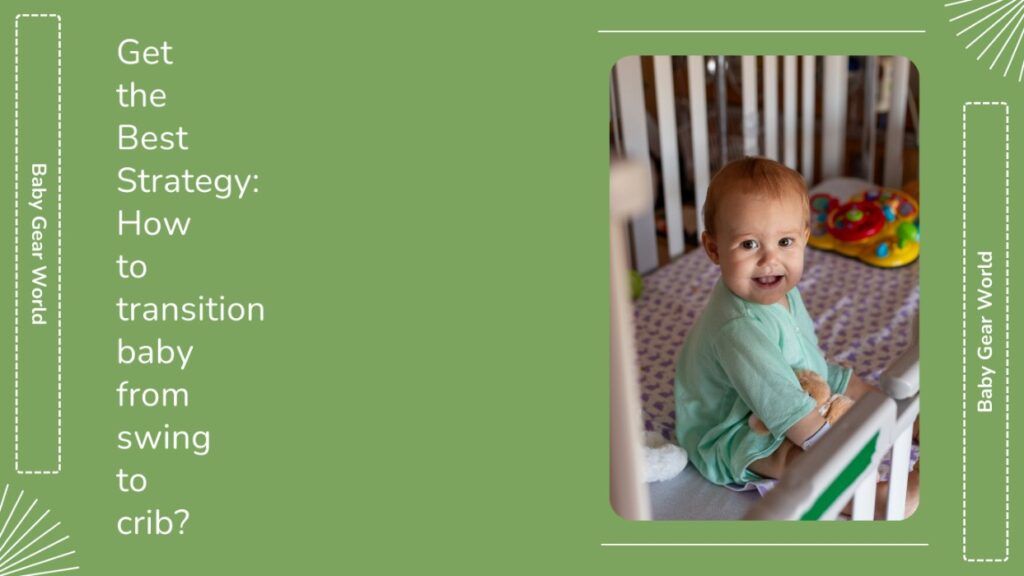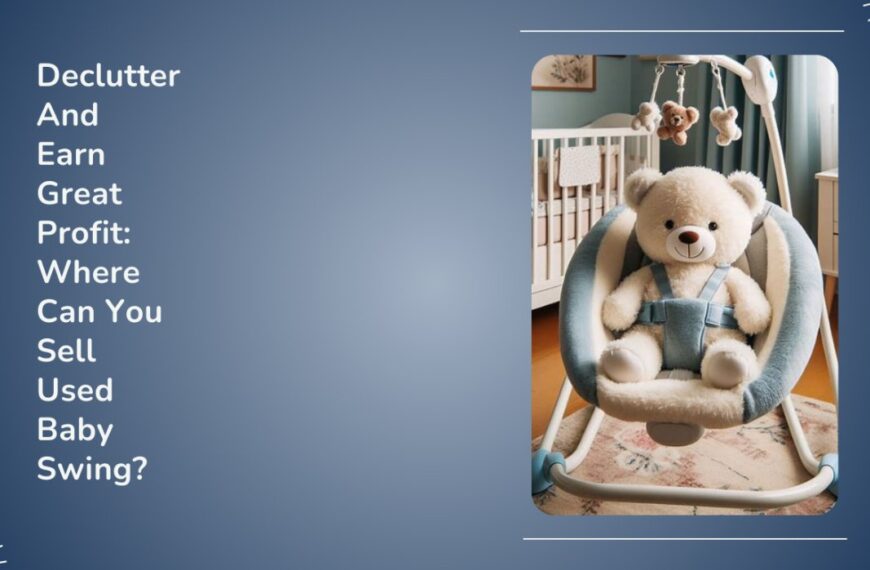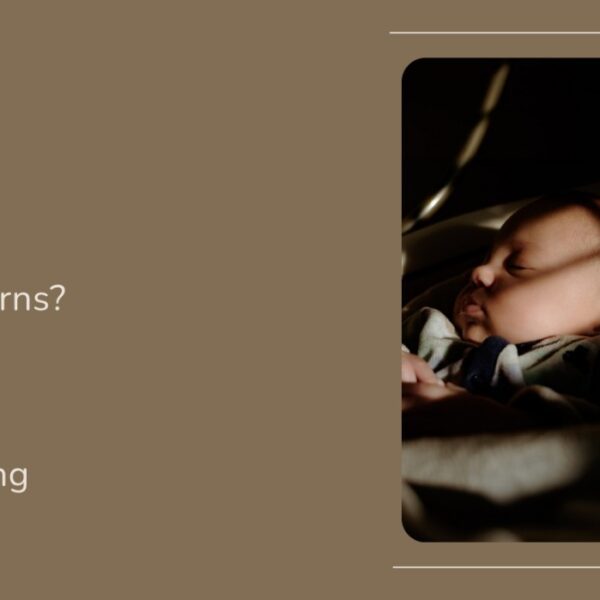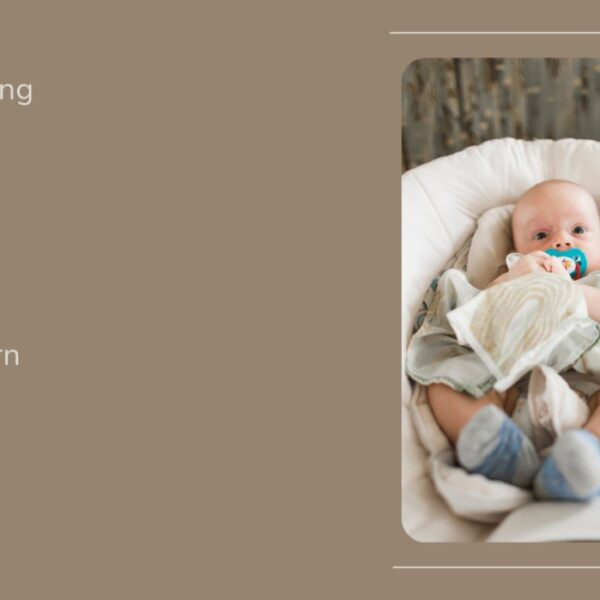Impact-Site-Verification: 73d029e6-7946-4ee3-bee1-90cb0ae74613
Imagine that peaceful moment when your baby sleeps in the soothing ambience of a baby swing.
Now, picture the challenge of transitioning your little one from the comforting swing to the crib.
I can almost see that crying little face.
I know it is hard for both of you.
If you are facing the same challenging situation, you are on the right page.
In this blog post, we’ll share the step-by-step method on how to transition baby from swing to crib as smoothly as possible.
We’ll also see what mistakes parents often make in this transition, which makes it more difficult for the baby, and how you can avoid them.
By the end of this post, you will have a clear and practical plan to transition your baby from swing to crib.
People Also Read: Are Baby Swings Safe for Sleeping?
Table of Contents
Why do you need to transition baby from swing to crib?
You need to know why moving your baby from the swing to the crib is important.
This will help you face the challenges of transitioning.
You should move your baby from the swing to the crib for many reasons.
The most important reason is that the swing is unsafe for your baby to sleep in for a long time.
The swing can cause your baby to have a bad posture or a flat head.
The swing can also fall over, break, and hurt your baby.
If the baby sleeps in the semi-reclined angle of the swing for a long time, it can become a reason for SIDS (Sudden Infant Death Syndrome).
Research on Infants’ deaths while sleeping shows that out of almost 12000 deaths, nearly 3% of cases happened in sitting devices like car seats, baby swings, etc.
Another reason is that the swing can make your baby depend on the motion and music to fall asleep.
This can make it hard for your baby to sleep in other places, such as the car, the stroller, or the crib.
The swing can also make your baby sleep too much or too little, messing up their sleep cycle.
The American Academy of Pediatrics suggests a baby should sleep on a flat, firm surface like a crib.
The crib can help your baby learn how to sleep independently without needing the swing motion and music.
The crib can also help your baby sleep better and longer and grow faster and healthier.
How to transition baby from swing to crib
Let’s look at the step-by-step process parents should follow to make the transition less challenging for the baby.
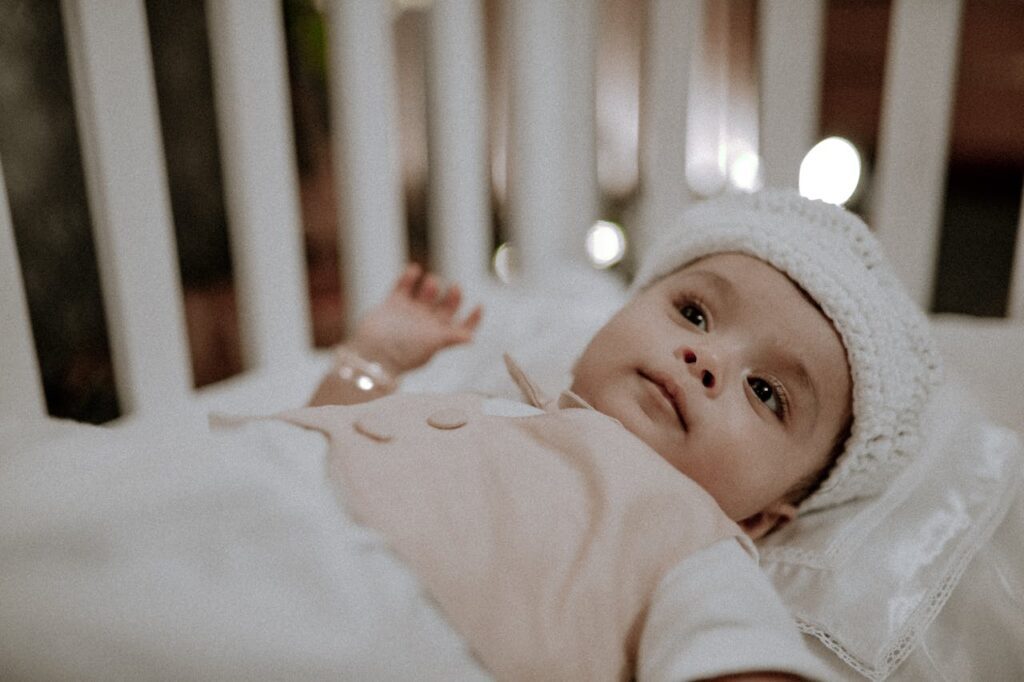
Moving the Swing Near to Crib
The first thing you need to do is to move the swing and place it near the crib in the room where you want your baby to sleep in the crib.
It’ll help your baby get used to the room environment where he will sleep in the coming days.
This way, he will not feel scared to sleep in the crib because of the unfamiliar environment.
If you have a portable or foldable swing, you can move it from one room to another without any problem.
However, if you have a full-sized swing, you have to disassemble it to move it to another room and have to put it back together.
Give Sleep Clues and Set a Proper Bedtime Routine
Make a regular bedtime routine for your baby.
Pick a specific time every day for your baby to sleep.
Use sleep cues to help your baby relax and sleep better.
Sleep cues are signals that tell your baby when it is time to sleep.
Some sleep cues are dimming the lights, playing white noise, giving a massage, using a pacifier, etc.
Using the same cues for both the swing and the crib makes the transition easier.
Your baby starts to connect these cues with sleep, no matter where they sleep.
This helps your baby feel safe and comfy in the new sleep place.
Decrease the Speed and Music Volume Step By Step
You have to gradually reduce the swing speed and motion at bedtime over several nights until your baby can sleep in a still swing.
You can start with the highest speed setting on the first night and lower it by one notch every night until you reach the lowest setting.
When your baby is used to sleeping at the lowest speed with no music, you can turn off the swing and put your baby in a non-moving swing.
Usually, this process takes nearly 2 weeks, but it can take longer, depending on the baby’s behaviour and temperament.
You must be patient and flexible and adjust your pace according to your baby’s response.
Introduce Crib as a Fun House
To make your baby feel happy and comfy in the crib, you need to turn it into a place they like.
Let your baby play in the crib when they’re awake during the day.
Add their favourite soft toys and a cozy blanket – things your baby likes.
The smell and touch of these things will help your baby feel safe and familiar in the crib.
When it’s bedtime, your baby will be more comfortable with going to sleep because the crib feels like a friendly and known space.
So, spend some playtime in the crib, add those cuddly toys, and make it a happy place for your little one.
It’ll make bedtime much easier!
Put Your Baby in the Crib for Sleep Time
Before putting your baby into the crib, make sure your baby is a bit sleepy and not hungry or uncomfortable.
You have to go with the same bedtime routine and sleep cues you used for the swing.
Repeat the same process if you were dimming the lights, playing white noise, or giving a pacifier.
The only difference is that instead of putting your baby in the swing, you put them in the crib.
Because your baby is already feeling sleepy and receiving the same sleep cues, there is a very high chance that your baby will sleep peacefully in the crib without much trouble.
This was the step-by-step process for transitioning your baby from the swing to the crib.
The transition time may go longer than expected, depending on your baby’s temperament and readiness.
However, this method is generally effective for most babies.
The key is to stay patient and be flexible with your transitioning steps if the baby shows resistance.
Keep on trying, stay consistent, and it will work.
Common Mistakes Parents Do While Transitioning
Parents often make a few mistakes that make this transitioning process more difficult for both parents and babies.
You need to know and avoid these mistakes to make this transition smoother for the baby.
Here are some of these mistakes and their solution:

Ignoring Baby’s Familiarity with the Swing
Parents sometimes forget that their baby has grown attached to the swing.
Suddenly removing it and expecting the baby to adapt quickly to the crib can lead to resistance and discomfort.
How to avoid it
Instead of a sudden switch, gradually integrate crib time during awake hours.
Let your baby play in the crib with their favourite toys.
This way, the crib becomes a friendlier space, easing the transition.
Skipping Consistent Sleep Cues
Neglecting the familiar sleep cues used with the swing, like dim lights or gentle music, can make the crib seem unfamiliar and less inviting for the baby.
How to avoid it
Maintain the same sleep cues in the crib you used with the swing.
It helps them associate the crib with sleep in a familiar way.
Impatient Behavior with Baby’s Resistance
Parents might get worried if their baby resists the crib initially.
Impatient behaviour can lead to frustration and anxiety and can make the transition more challenging.
How to avoid it
Be patient.
If your baby resists, show affection towards the baby.
Spend more time with them in the crib during playtime, creating positive associations.
By being aware of these common mistakes and adopting these solutions, parents can make the transition from swing to crib a more positive and comfortable experience for themselves and their little ones.
Conclusion
We hope you have enjoyed our guide on “How to transition baby from swing to crib”.
Remember that every little step counts, and it’ll help you and your baby get closer to peaceful nights.
Patience, familiarity, and consistency are the keys to a successful transition.
As you start this process, remember that every baby is unique, and the transition might have twists.
It can take time, and you need to be patient if your baby resists during the transition.
Have fun with the journey, be proud of every achievement, and soon, the crib will be a warm and cozy place for your baby’s dreams.
Happy sleeping!
Related Blog Posts
